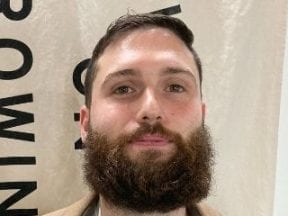Shopping in-store for wedding rings does not appeal to all men. That was an insight of Johnathan Ruggiero and his wife Michelle when they founded Manly Bands, a direct-to-consumer online wedding-ring company, in 2016. The second insight was the rings had to be unique — really unique — to compete against established jewelers.
“We try to develop what we call show-stopper products,” Johnathan told me. “People might say, ‘You have dinosaur bones? That’s crazy. You have meteorite? That’s nuts.'”
Yes, Manly Bands makes men’s wedding rings from dinosaur bones, meteorites, whiskey barrels, and more.
My recent conversation with Johnathan addressed the company’s founding, product selection, marketing tactics, and fulfillment — among other topics. The entire audio interview is embedded below. The transcript that follows is edited for length and clarity.
Eric Bandholz: We met two years ago. Your company has done so much since then.
Johnathan Ruggiero: The last couple of years have been a whirlwind at Manly Bands. We have 35 employees, almost double from two years ago. We’re now in a warehouse and fulfilling in-house.
When you and I met, the company was just Michelle — my wife, co-founder, and co-CEO — and maybe seven employees, mostly in marketing and customer service. We were using a third-party fulfillment company. Before that, we were fulfilling ourselves out of our garage in Florida, where she and I launched the business in 2016.
Having a 3PL freed us to focus more on customer service, product development, marketing — just growing the company.
Eventually, Michelle and I settled in Utah, which is a great combination of desert, trees, lakes, and mountains. And the entrepreneurial spirit is unbelievable. We’ve been here for about a year and a half.
Bandholz: You went from seven employees to 35 in two years.
Ruggiero: As your listeners know, it’s not easy to grow a team five times in a couple of years. It’s been challenging finding the right people. Nowadays the remote culture is common. Thankfully, we started that way. We launched in Florida with a remote team in mind. We had team members in California and Massachusetts. So once Covid hit, working remotely wasn’t a foreign idea.
We’ve roughly doubled revenue year over year, creating a need for more staff. So now, in Utah, we have a warehouse and our own fulfillment team. That was a big factor in growth. As we get more orders, we can fulfill them and process exchanges and returns. Our customer service team is also here in Utah. It’s about nine folks now. With more orders come more emails, phone calls, text messages, Facebook messages — all of that.
We’ve also expanded our marketing team to include some videographers, editors, and creative directors.
Bandholz: Why bring fulfillment back in-house?
Ruggiero: We had a wonderful 3PL, called Ships-a-Lot. The company is located in Memphis. They were fantastic. We loved working with them, and we still have a great relationship. What we found, though, is that as we began to scale, it made sense from a cost-savings perspective to bring it in-house. We have hourly employees to process the orders and get them out the door and manage fulfillment supplies. We have a lot more space in the warehouse. It makes more sense financially once you hit a certain level.
Bandholz: Do you have a lot of returns and exchanges?
Ruggiero: We sell men’s wedding rings. Most men don’t know their ring size. We see an exchange rate of close to 20 percent. It’s not a huge problem. We can process a return right away.
Bandholz: You have many ring types — made from antlers, meteorites, wood, you name it. How do you develop these products?
Ruggiero: One way to stand out is to create products that folks couldn’t get in a traditional store. They have no choice but to buy it online from us.
We try to develop what we call show-stopper products. People might say, “You have dinosaur bones? That’s crazy. You have meteorite? That’s nuts.”
Michelle is great at developing products. She and her team survey consumers to understand what they want. We always try to create something unique and different. That has helped distinguish us from the independent jewelry stores and the Kays, the Jared’s, and the Zales. So we provide a product that folks cannot get anywhere else.
Bandholz: Do you produce the rings in-house?
Ruggiero: About 80 percent of the rings on our site are manufactured in the U.S. in-house or with manufacturing partners. And then we source about 20 percent from all over the world. We’re always looking for great artisans and craftsmen that work with cool materials such as guitar strings and baseball-bat wood.
We just launched a partnership with Jack Daniels. We’re licensing the Jack Daniels name. We buy the company’s whiskey barrels and make rings from them. We do whatever we can to stand out and be different.
We had a generic whiskey barrel ring for a couple of years now. Once we obtained the Jack Daniel’s name and could say that we’re the only official Jack Daniels ring maker in the country, our sales doubled on that type of product. So the partnership has been hugely valuable.
Bandholz: What are your marketing tactics?
Ruggiero: Mostly via traditional digital ads. We’ve advertised on Facebook and Google since we started in 2016. But we’re exploring other channels now with lower CPMs and CPAs. We’re looking at outdoor billboards, bus stop signs, subway signs — things like that.
We’re also doing podcasts and getting on traditional radio and television. We’ve doubled down on television this year. It’s close to 15 percent of our overall ad spend. We want to hit people from a different direction and not necessarily where everybody’s advertising.
So far, we’ve actually seen our CPM costs go down for traffic to the site. And I think it’s because we’re mixing these less popular channels. Perhaps they’re more expensive in the short term, but overall, it’s reducing our traffic costs.
Bandholz: I’ve seen your television commercial. Was that from an agency?
Ruggiero: Yes. It was Creatably.com. They were fantastic. They jumped on the production. We started the day after we met with them in terms of writing the script.
It was definitely a learning process. We’ve done two commercials now with Creatably. We’ve learned so much. Michelle and I come from Los Angeles in the entertainment industry. But doing a full-blown creative commercial for a direct-to-consumer brand is a different experience for us.
Even though it was just a couple of days, it’s expensive. That was the first thing we learned. And then, the whole post-production process is long — many iterations. But it was great in the end. It’s a three to six-month process.
We all sat down as a team and picked the script that we thought would have legs. Once we decided on the script, we moved to produce the episode. Casting was a big deal, getting the characters.
Then the exciting part was shooting. We shot for a week. We did three or four commercials. It was exciting. And then it took a month or two to edit and finalize. And then we launched, about six months after we started.
Bandholz: Was it worth the investment? I’m thinking $25,000 to $50,000 to produce. Is that the range?
Ruggiero: It’s closer to 10 times that. But it was worth it. We’ve doubled sales year over year, and that video was a big contributor. It did eat up a lot of our cash flow for the year. But overall it was worth it.
It’s the same thing with television advertising overall. It cuts into our cash flow. It’s expensive. But it has also opened a lot of doors for us.
The benefits go beyond direct, immediate sales. We’ve gotten hundreds of thousands of folks to our website every month because of it. But it’s also about the relationships we’ve gained, the press coverage. So it was pretty substantial for the holistic benefits to the business.
Bandholz: What do you wish you had started earlier, from day one?
Ruggiero: I should have delegated more. I didn’t always have faith in other people to have my same passion and commitment. That’s a huge detriment to an entrepreneur. There are so many talented people out there.
Manly Bands has grown not because of Michelle and me but because of our team. The sooner owners realize it’s okay to delegate, the faster they can succeed.
Bandholz: How can listeners learn more about you and Manly Brands?
Ruggiero: I’m on Twitter and LinkedIn. Our website is Manlybands.com. We’re on all major social sites — Instagram, Facebook, Twitter.




